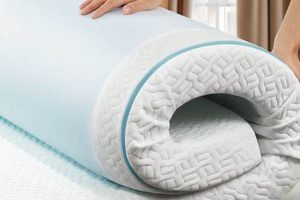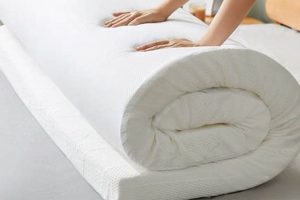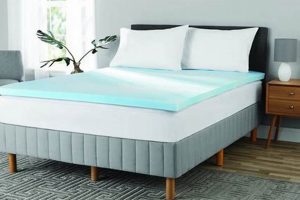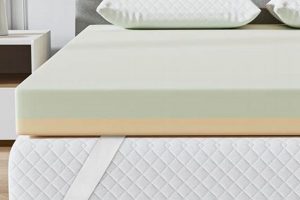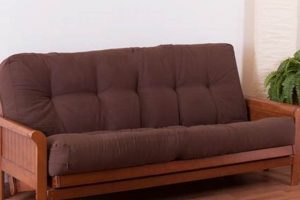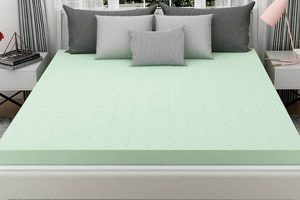A sleeping surface designed specifically for bunk bed frames, measuring eight inches in thickness and sized to fit a twin bed, is a common choice for maximizing space in shared rooms or accommodating children. These mattresses provide a balance of comfort and support while adhering to the height restrictions often imposed by bunk bed designs, ensuring safety and preventing obstruction of upper bunk guardrails.
The selection of an appropriately sized and constructed sleeping surface for a bunk bed is crucial for ensuring occupant safety and comfort. A thinner profile reduces the risk of exceeding the safe height limit for the top bunk, thereby preventing falls. Historically, these mattresses have evolved from simple innerspring designs to include memory foam and hybrid constructions, offering improved pressure relief and spinal alignment for a more restful sleep experience. Their use also contributes to efficient space utilization, a significant advantage in smaller living environments.
Considerations for selecting the ideal sleeping solution for a bunk bed often involve evaluating factors such as material composition, firmness level, and potential for off-gassing. Additionally, budget constraints and the intended user’s individual preferences play a significant role in the decision-making process. The following sections will delve deeper into these crucial aspects, providing a comprehensive guide to choosing the most suitable option.
Selection Guidelines for Eight-Inch Twin Mattresses Intended for Bunk Beds
The following guidelines provide essential considerations when selecting an eight-inch twin mattress for use on a bunk bed, ensuring both safety and long-term satisfaction.
Tip 1: Verify Height Compatibility: Prior to purchase, confirm the mattress’s eight-inch thickness adheres to the bunk bed manufacturer’s specified maximum mattress height. Exceeding this limit compromises safety by reducing the height of the guardrail.
Tip 2: Evaluate Material Composition: Explore options such as memory foam, innerspring, or hybrid constructions. Memory foam offers pressure relief, while innerspring provides traditional support. A hybrid combines the benefits of both.
Tip 3: Assess Firmness Level: Consider the sleeper’s weight and preferred sleeping position. Lighter individuals or side sleepers may benefit from a softer surface, while heavier individuals or back/stomach sleepers may require a firmer option.
Tip 4: Investigate Fire Retardancy Compliance: Ensure the mattress meets or exceeds federal fire safety standards, as this is a critical safety requirement, particularly for children’s bunk beds.
Tip 5: Examine Edge Support: Adequate edge support prevents roll-off, especially important for the top bunk. Look for reinforced edges or designs that minimize compression along the perimeter.
Tip 6: Consider Weight Capacity: Verify the mattress’s weight capacity and ensure it is sufficient for the intended user. Exceeding the weight limit can damage the mattress and compromise its support.
Tip 7: Review Warranty and Return Policies: A comprehensive warranty and favorable return policy offer protection against defects and allow for a trial period to assess comfort and suitability.
Selecting the appropriate eight-inch twin mattress for a bunk bed involves carefully considering safety regulations, material properties, and individual comfort preferences. Adhering to these guidelines will contribute to a secure and restful sleeping environment.
The subsequent sections will address specific types of mattresses suitable for bunk beds, focusing on the advantages and disadvantages of each construction method.
1. Thickness Compliance
Thickness compliance, in the context of an eight-inch twin mattress intended for a bunk bed, refers to adherence to the height restrictions stipulated by bunk bed manufacturers and safety guidelines. This compliance is not merely a suggestion but a critical safety requirement designed to prevent accidents and ensure the proper functionality of the bunk bed structure.
- Guardrail Height Assurance
The primary reason for thickness compliance is to maintain adequate guardrail height on the upper bunk. If the mattress is too thick, it reduces the effective height of the guardrail, increasing the risk of falls. A mattress exceeding the recommended thickness, even by a small amount, can negate the safety features designed into the bunk bed frame. For example, a bunk bed designed for a maximum mattress thickness of eight inches would have guardrails engineered to a specific height based on this constraint. Using a thicker mattress would render these guardrails insufficient.
- Ladder Accessibility Maintenance
Mattress thickness directly affects the accessibility of the bunk bed ladder. An overly thick mattress can make it difficult or even dangerous for individuals to climb onto the top bunk, as the distance between the top of the mattress and the ladder rungs becomes disproportionate. This can lead to awkward and potentially hazardous climbing maneuvers. In practical terms, a child attempting to ascend a ladder to a bunk bed with an excessively thick mattress may struggle to reach the upper rungs comfortably, increasing the likelihood of a fall.
- Structural Integrity Preservation
While less direct than guardrail height, mattress thickness can subtly impact the structural integrity of the bunk bed. Overly thick mattresses, especially those constructed from dense materials, can add extra weight to the bunk bed frame, potentially straining its joints and supports over time. This is particularly relevant for bunk beds made from less robust materials. For instance, a bunk bed constructed from lightweight metal tubing may be more susceptible to stress fractures or bending under the combined weight of a thick mattress and a person sleeping on it.
- Regulatory Standard Adherence
In many jurisdictions, bunk beds are subject to specific safety regulations and standards, often incorporating mattress thickness as a key compliance parameter. These regulations are designed to minimize the risk of injury associated with bunk bed use. Failure to adhere to these regulations can result in legal liabilities for manufacturers and retailers, and, more importantly, can jeopardize the safety of the end-users. For example, certain jurisdictions may mandate that bunk beds sold for residential use must include a label specifying the maximum permissible mattress thickness.
In summary, thickness compliance for an eight-inch twin mattress on a bunk bed is not an arbitrary specification but a critical safety requirement with far-reaching implications. From maintaining adequate guardrail height and ensuring safe ladder accessibility to preserving structural integrity and complying with regulatory standards, adhering to the recommended thickness is essential for creating a safe and functional sleeping environment.
2. Support and Comfort
The elements of support and comfort are paramount considerations when selecting an eight-inch twin mattress for a bunk bed. These characteristics directly impact sleep quality, physical well-being, and overall user satisfaction. The design and materials of the mattress must provide adequate spinal alignment and pressure relief while adhering to the safety constraints inherent in bunk bed configurations.
- Spinal Alignment and Posture
A properly supportive mattress maintains natural spinal alignment, preventing back pain and discomfort. In the context of a bunk bed mattress, this is particularly important for growing children and adolescents whose skeletal systems are still developing. For example, a mattress that is too soft may allow the spine to curve excessively, leading to poor posture and potential long-term back problems. Conversely, a mattress that is too firm may not conform to the body’s contours, resulting in pressure points and discomfort.
- Pressure Relief and Circulation
Effective pressure relief is crucial for promoting healthy circulation and preventing numbness or tingling during sleep. Mattresses that evenly distribute weight and minimize pressure points on areas such as the shoulders, hips, and knees contribute to a more restful sleep experience. An eight-inch twin mattress with a memory foam layer, for instance, can effectively contour to the body, alleviating pressure points and improving circulation compared to a traditional innerspring mattress.
- Material Composition and Breathability
The materials used in the construction of a bunk bed mattress play a significant role in its comfort and breathability. Certain materials, such as open-cell memory foam or latex, promote airflow and dissipate heat, preventing overheating and night sweats. In contrast, closed-cell foams or non-breathable fabrics can trap heat and moisture, leading to discomfort. For example, a mattress with a breathable cotton cover and a layer of gel-infused memory foam can provide a cooler and more comfortable sleeping surface than a mattress with a synthetic cover and traditional memory foam.
- Firmness and Personal Preference
Individual preferences for firmness levels vary widely, and the ideal firmness depends on factors such as body weight, sleeping position, and personal comfort thresholds. While some individuals prefer a firm mattress for its perceived support, others find a softer mattress more comfortable. In the context of an eight-inch twin mattress for a bunk bed, it is essential to strike a balance between support and comfort to accommodate a range of preferences. For example, a medium-firm mattress may be a suitable compromise for users who are unsure of their preferred firmness level.
The interconnectedness of spinal alignment, pressure relief, material composition, and firmness underscores the importance of carefully considering these factors when selecting an eight-inch twin mattress for a bunk bed. A mattress that effectively addresses these elements contributes to a more comfortable, supportive, and restorative sleep experience, particularly crucial for children and adolescents using bunk beds on a regular basis.
3. Fire Safety Standards
The relationship between fire safety standards and an eight-inch twin mattress intended for a bunk bed is a critical consideration directly impacting user safety. These standards are not optional; they are mandatory requirements aimed at mitigating the risk of fire-related injuries and fatalities. Mattresses, due to their composition and placement, can be significant contributors to fire spread, making adherence to these standards paramount. For example, a mattress failing to meet fire safety standards could ignite rapidly, producing toxic fumes and intensifying the fire, potentially hindering evacuation efforts and increasing the risk to occupants.
Specific fire safety standards, such as those outlined in 16 CFR Part 1633 (Open Flame Standard) and 16 CFR Part 1632 (Smolder Resistance Standard), dictate the permissible flammability levels of mattresses sold in the United States. These regulations mandate that mattresses resist ignition from open flames (e.g., a lighter) and smoldering materials (e.g., a cigarette). Manufacturers achieve compliance through the use of fire-resistant materials, chemical treatments, or specialized construction techniques. The practical application of these standards is evident in the presence of warning labels on mattresses, indicating their compliance and providing consumers with assurance of their safety. Bunk beds, often used by children, amplify the importance of fire-resistant mattresses due to the potentially reduced escape routes and increased vulnerability of the occupants.
In summary, the integration of fire safety standards into the design and manufacture of an eight-inch twin mattress for a bunk bed is a non-negotiable element in safeguarding user well-being. Compliance with these standards minimizes the risk of fire ignition and propagation, providing crucial protection for occupants, particularly in confined spaces such as bedrooms with bunk beds. Neglecting these standards poses significant safety hazards and legal ramifications, underscoring the importance of prioritizing fire safety in mattress selection and use.
4. Durability Expectations
The correlation between durability expectations and an eight-inch twin mattress intended for a bunk bed is significant, directly influencing the long-term value and safety of the product. A bunk bed mattress, often subjected to rigorous use by children or adolescents, must withstand considerable wear and tear, including jumping, prolonged static loads, and potential spills. Failure to meet reasonable durability expectations can result in premature degradation of the mattress, compromising its support, comfort, and even its structural integrity. For instance, an innerspring mattress with low-quality coils may sag or break down quickly under sustained pressure, diminishing its ability to provide proper spinal alignment. Similarly, a foam mattress composed of low-density materials may compress permanently over time, losing its cushioning properties and reducing its overall comfort.
Meeting durability expectations necessitates careful selection of materials and construction techniques. High-density foams, reinforced coil systems, and durable cover fabrics contribute to a longer lifespan and sustained performance. For example, a hybrid mattress incorporating pocketed coils and high-density memory foam is likely to exhibit greater resilience to wear and tear compared to a traditional innerspring mattress with open coils and low-density foam. Additionally, proper maintenance, such as regular rotation of the mattress, can further extend its lifespan. The implications of inadequate durability extend beyond mere economic considerations; a compromised mattress can contribute to poor sleep quality, increased risk of back pain, and potential safety hazards if the structural integrity is significantly affected.
In summary, durability expectations are integral to the selection of an eight-inch twin mattress for a bunk bed. Prioritizing mattresses constructed from robust materials and employing sound construction methods ensures a longer lifespan, sustained performance, and enhanced safety for the user. Failure to address durability concerns can lead to premature mattress degradation, compromised sleep quality, and potential safety risks, underscoring the importance of considering longevity as a primary factor in the purchasing decision.
5. Space Optimization
Space optimization, in the context of selecting an eight-inch twin mattress for a bunk bed, is a crucial consideration driving purchasing decisions. The dimensions and design of a sleeping arrangement must align with the physical constraints of the room, particularly in smaller living spaces. A bunk bed inherently represents a strategy for vertical space utilization, and the mattress selection directly influences the effectiveness of this strategy.
- Vertical Space Efficiency
The primary benefit of a bunk bed is its ability to house two sleeping surfaces within the footprint of a single bed. An eight-inch twin mattress is typically chosen to maintain a balance between comfort and headroom on both bunks. A thicker mattress would reduce the available space between the upper bunk and the ceiling, potentially creating a claustrophobic environment. The chosen thickness ensures usability of both sleeping levels without compromising on necessary comfort.
- Room Layout Flexibility
The compact nature of a bunk bed, facilitated by the appropriately sized mattress, allows for greater flexibility in room layout. The freed-up floor space can then be used for other essential furniture items like desks, storage units, or play areas, especially important in shared bedrooms. An excessively bulky mattress would negate some of these space-saving advantages, making it more challenging to arrange the room effectively.
- Accessibility and Maneuverability
An eight-inch mattress, in conjunction with a bunk bed design, impacts the ease of access to the top bunk. A mattress that is too thick can make it more difficult to climb onto the upper bunk, particularly for younger children. It can also impede changing sheets and general maintenance of the sleeping area. The dimensions must allow for safe and convenient access and upkeep.
- Storage Integration
Some bunk bed designs incorporate under-bed storage options, such as drawers or trundle beds. The selection of an eight-inch twin mattress is essential for ensuring these storage features remain functional. A thicker mattress would reduce the clearance beneath the bed, potentially obstructing access to or the full utilization of the storage space. Therefore, compatibility with integrated storage is an important factor in mattress selection.
These facets highlight the integral role of space optimization in choosing an eight-inch twin mattress for a bunk bed. The selected mattress must not only provide adequate comfort and support but also facilitate efficient use of vertical space, allow for flexible room layouts, ensure safe access, and integrate seamlessly with storage solutions. The combination of these factors contributes to creating a functional and comfortable living environment, especially within confined spaces.
Frequently Asked Questions
This section addresses common inquiries regarding eight-inch twin mattresses specifically designed for bunk bed applications. The aim is to provide clarity on selection criteria, safety considerations, and performance expectations.
Question 1: What is the primary safety concern associated with using a mattress thicker than eight inches on a bunk bed?
The primary safety concern is reduced guardrail height. Bunk beds are designed with specific guardrail heights to prevent falls. A thicker mattress diminishes this height, increasing the risk of an occupant falling from the upper bunk.
Question 2: Does the material composition of an eight-inch twin mattress affect its suitability for a bunk bed?
Yes, material composition is a critical factor. Mattresses intended for bunk beds should prioritize fire retardancy and support. Memory foam, innerspring, and hybrid constructions are viable options, but each should be evaluated for appropriate firmness and adherence to safety standards.
Question 3: How does mattress firmness impact the comfort and suitability of an eight-inch twin mattress for a bunk bed?
Mattress firmness directly affects comfort and spinal alignment. The ideal firmness depends on the sleeper’s weight and preferred sleeping position. A mattress that is too soft may lack support, while one that is too firm may cause pressure points.
Question 4: Are there specific fire safety regulations that eight-inch twin mattresses for bunk beds must meet?
Yes, mattresses must comply with federal fire safety standards, such as 16 CFR Part 1632 and 16 CFR Part 1633. These regulations address smolder resistance and open flame resistance to minimize fire hazards.
Question 5: How does the weight capacity of an eight-inch twin mattress influence its suitability for a bunk bed?
The weight capacity must be sufficient for the intended user. Exceeding the weight limit can damage the mattress, compromise its support, and potentially create a safety hazard. Weight capacity specifications should always be verified prior to purchase.
Question 6: What role does edge support play in the performance of an eight-inch twin mattress on a bunk bed?
Adequate edge support prevents roll-off, particularly on the upper bunk. Strong edge support enhances stability and provides a more consistent sleeping surface across the entire mattress.
In conclusion, the selection of an eight-inch twin mattress for a bunk bed requires careful consideration of safety standards, material properties, comfort preferences, and weight limitations to ensure both a safe and satisfactory sleep experience.
The subsequent section will provide guidance on maintenance and care practices to extend the lifespan of an eight-inch twin mattress used on a bunk bed.
Conclusion
The preceding analysis clarifies the multifaceted considerations involved in selecting an eight-inch twin mattress specifically for bunk bed use. Factors such as adherence to safety regulations regarding thickness and fire resistance, the influence of material composition on comfort and support, and the importance of durability for long-term performance have been comprehensively explored. The discussion underscored the significance of aligning mattress characteristics with the specific needs and limitations of a bunk bed environment.
The informed selection of an eight-inch twin mattress for bunk bed applications transcends mere convenience; it represents a proactive commitment to safety, well-being, and the efficient utilization of space. Prioritizing these considerations ensures a sleep environment that is not only comfortable and supportive but also conducive to the long-term health and safety of its occupants. Ongoing vigilance regarding product standards and proper usage remains paramount.


